

高等学校化学学报 ›› 2023, Vol. 44 ›› Issue (5): 20220721.doi: 10.7503/cjcu20220721
张硕1,2, 丁俊凡1,2, 许睿1,2, 黄佳琦1,2( )
)
收稿日期:2022-11-15
出版日期:2023-05-10
发布日期:2023-02-01
通讯作者:
黄佳琦
E-mail:jqhuang@bit.edu.cn
基金资助:
ZHANG Shuo1,2, DING Junfan1,2, XU Rui1,2, HUANG Jiaqi1,2( )
)
Received:2022-11-15
Online:2023-05-10
Published:2023-02-01
Contact:
HUANG Jiaqi
E-mail:jqhuang@bit.edu.cn
Supported by:摘要:
金属锂负极具有极高的理论比容量和极低的氧化还原电位, 被认为是二次电池体系中负极材料的最终选择. 但在实际应用过程中, 不稳定的电极/电解液界面会造成大量的锂枝晶生长, 导致容量损失乃至热失控等安全问题. 调控锂离子溶剂化结构, 可促进有益的固态电解质界面膜(SEI)成膜组分在电极表面优先分解, 进而稳定电极界面并可诱导锂离子均匀沉积, 是提升液态和准固态金属锂电池电化学性能的重要手段. 本文综合评述了近年来从液态到准固态电解质中锂离子溶剂化结构调控的策略和设计原则, 探讨了溶剂化结构改变对电极/电解质界面的影响, 并对准固态电解质的研究前景进行了展望.
中图分类号:
TrendMD:
张硕, 丁俊凡, 许睿, 黄佳琦. 金属锂负极溶剂化结构调控的研究进展. 高等学校化学学报, 2023, 44(5): 20220721.
ZHANG Shuo, DING Junfan, XU Rui, HUANG Jiaqi. Progress on the Solvation Structure Regulation of Li Ion for Stable Lithium Metal Anode. Chem. J. Chinese Universities, 2023, 44(5): 20220721.
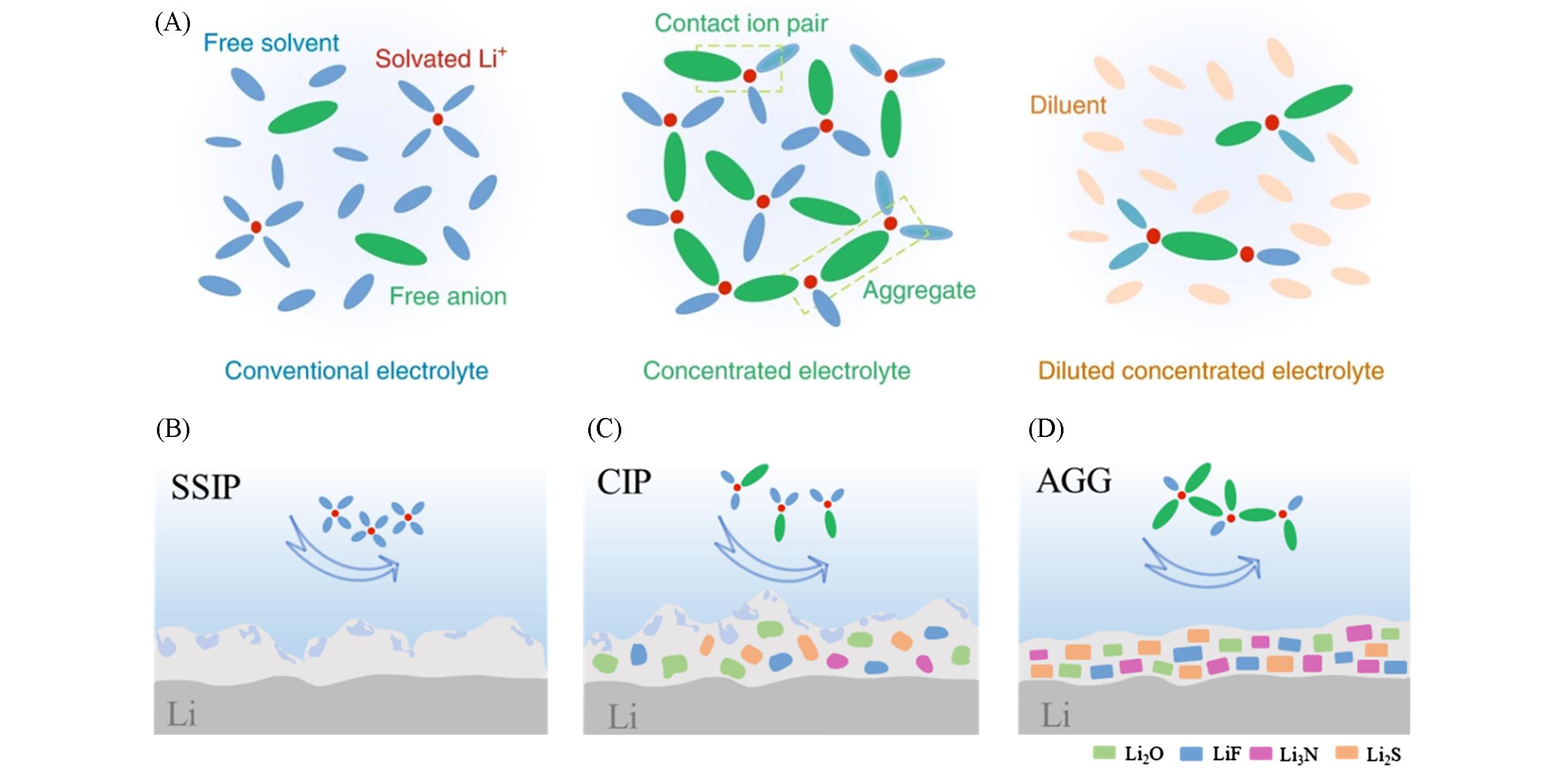
Fig.1 Schematics of solvation structures of the three electrolytes(conventional dilute electrolyte, concentrated electrolyte and diluted concentrated electrolyte)(A) [ 56] and diverse SEI derived from different solvation structures: SSIP(B), CIP(C), AGG(D)(A) Copyright 2019, Springer Nature.
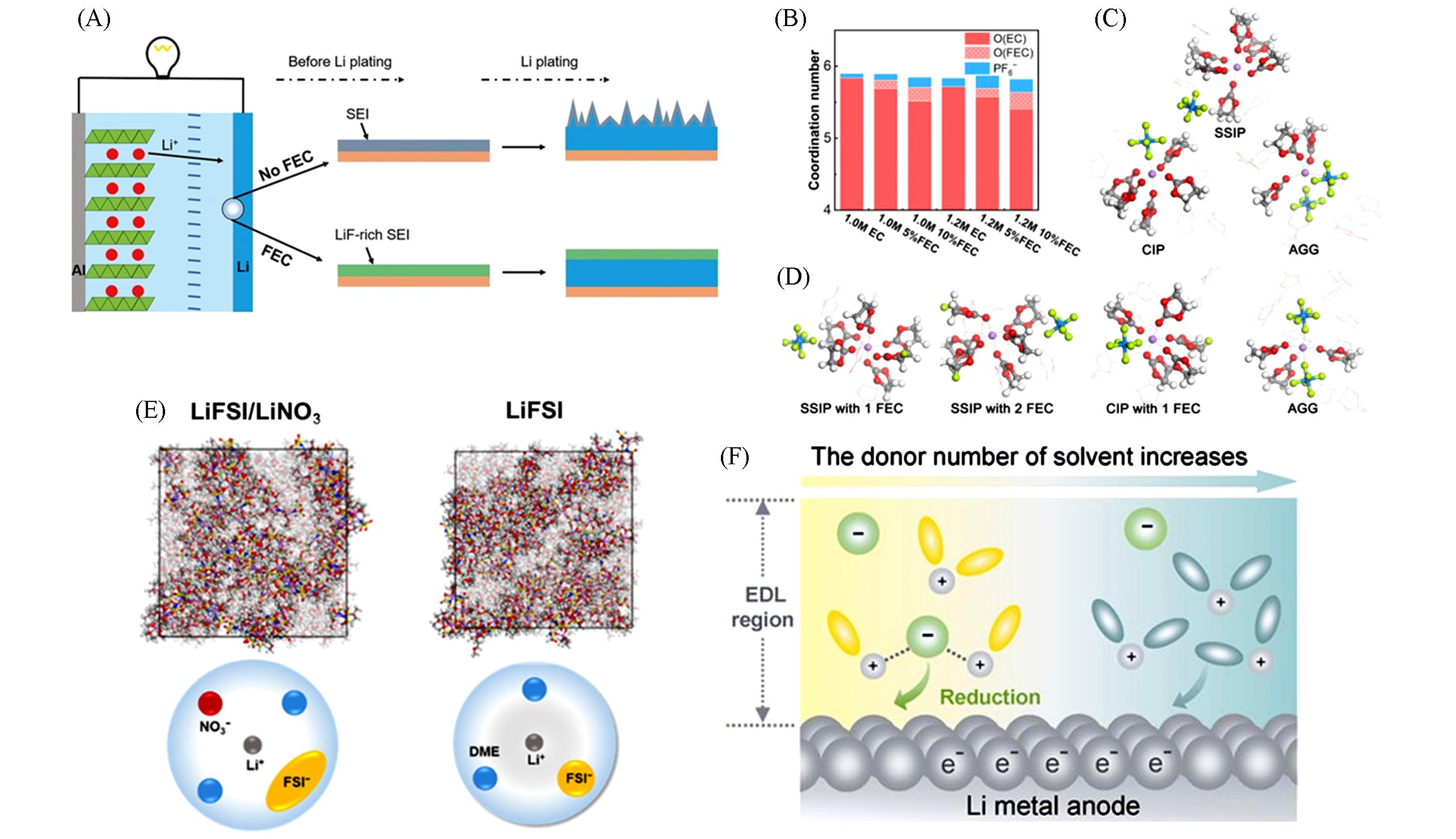
Fig.2 Schematic of the effect of FEC additives on a Li metal anode(A) [ 63], the calculated total coordination number for Li + in LiPF6 in EC with 0, 5%, 10% FEC(B), the representative solvation structures taken from molecular dynamics(MD) simulation snapshots of 1 mol/L LiPF6 in EC(C) and 1 mol/L LiPF6 in EC with 10% FEC(D) [ 64], snapshots of the MD simulation boxes of LiFSI/LiNO3 and LiFSI electrolyte(top panel), schematics of the solvation structure of Li ions in corresponding electrolyte(bottom panel)(E) [ 65] and schematic illustration of the EDL principle in screening reactants to preferentially construct the SEI(F) [ 60](A) Copyright 2017, John Wiley and Sons; (B—D) Copyright 2019, Elsevier; (E) Copyright 2019, American Chemical Society; (F) Copyright 2021, John Wiley and Sons.
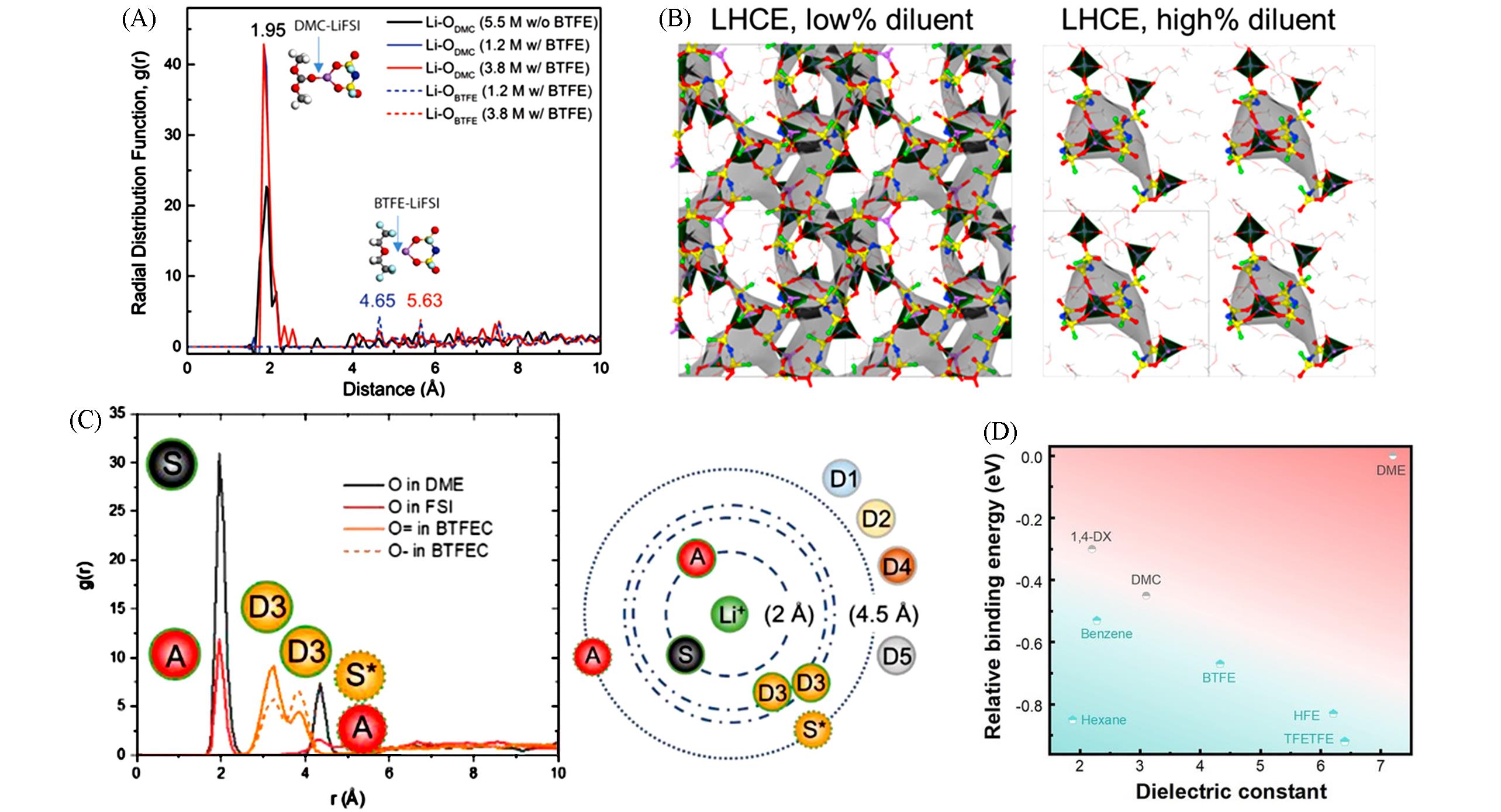
Fig.3 Radial distribution functions of Li⁃ODMC and Li⁃OBTFE pairs(A) [ 75], three⁃dimensional solvation structures in LHCE formulations with different diluent content(B) [ 76], radial distribution of LHCE with BTFEC and schematic illustration of the radial distribution of LHCE(C) [ 78] and the solvent diagram with regard to relative binding energy towards Li + and dielectric constant(D) [ 79](A) Copyright 2018, John Wiley and Sons; (B) Copyright 2020, American Chemical Society; (C) Copyright 2021, National Academy of Sciences; (D) Copyright 2021, John Wiley and Sons.
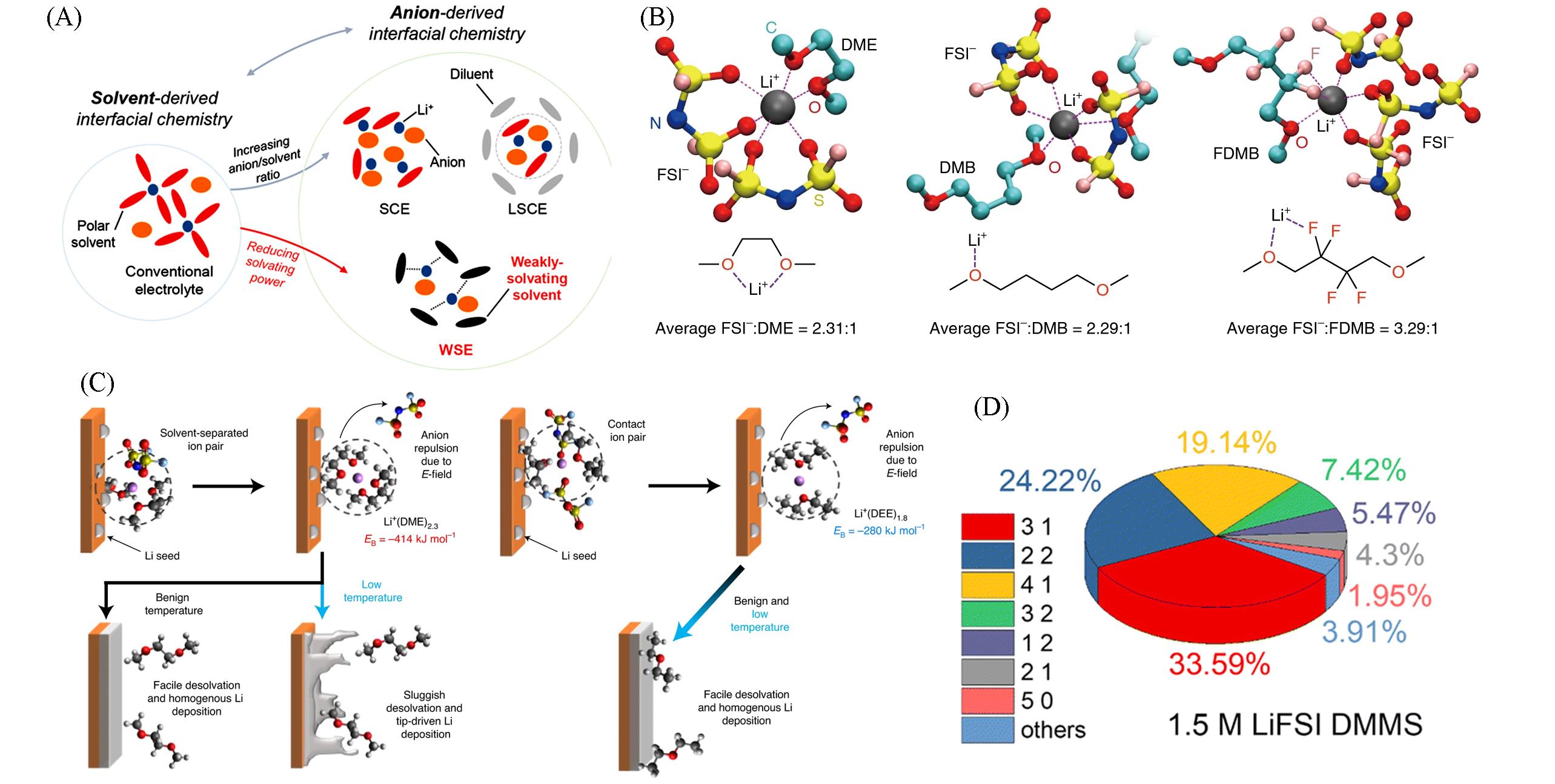
Fig.4 Solvation structures in conventional electrolyte, superconcentrated electrolyte(SCE), localized superconcentrated electrolyte(LSCE), and weakly solvating electrolyte(WSE)(A) [ 57], solvation structure of 1 mol/L LiFSI/DME, 1 mol/L LiFSI/DMB and 1 mol/L LiFSI/FDMB given by MD simulations and the corresponding average ratio of solvation bindings from FSI - anions to those from solvents in the solvation sheath(B) [ 85], proposed desolvation mechanisms and corresponding Li + binding energies obtained from quantum chemistry simulations in 1 mol/L LiFSI DOL/DME and 1 mol/L LiFSI DEE(C) [ 90] and statistical results of anion⁃solvent number in the first solvent sheath of Li + in 1.5 mol/L LiFSI DMMS electrolyte(D) [ 91](A) Copyright 2020, John Wiley and Sons; (B) Copyright 2020, Springer Nature; (C) Copyright 2021, Springer Nature; (D) Copyright 2022, the Royal Society of Chemistry.
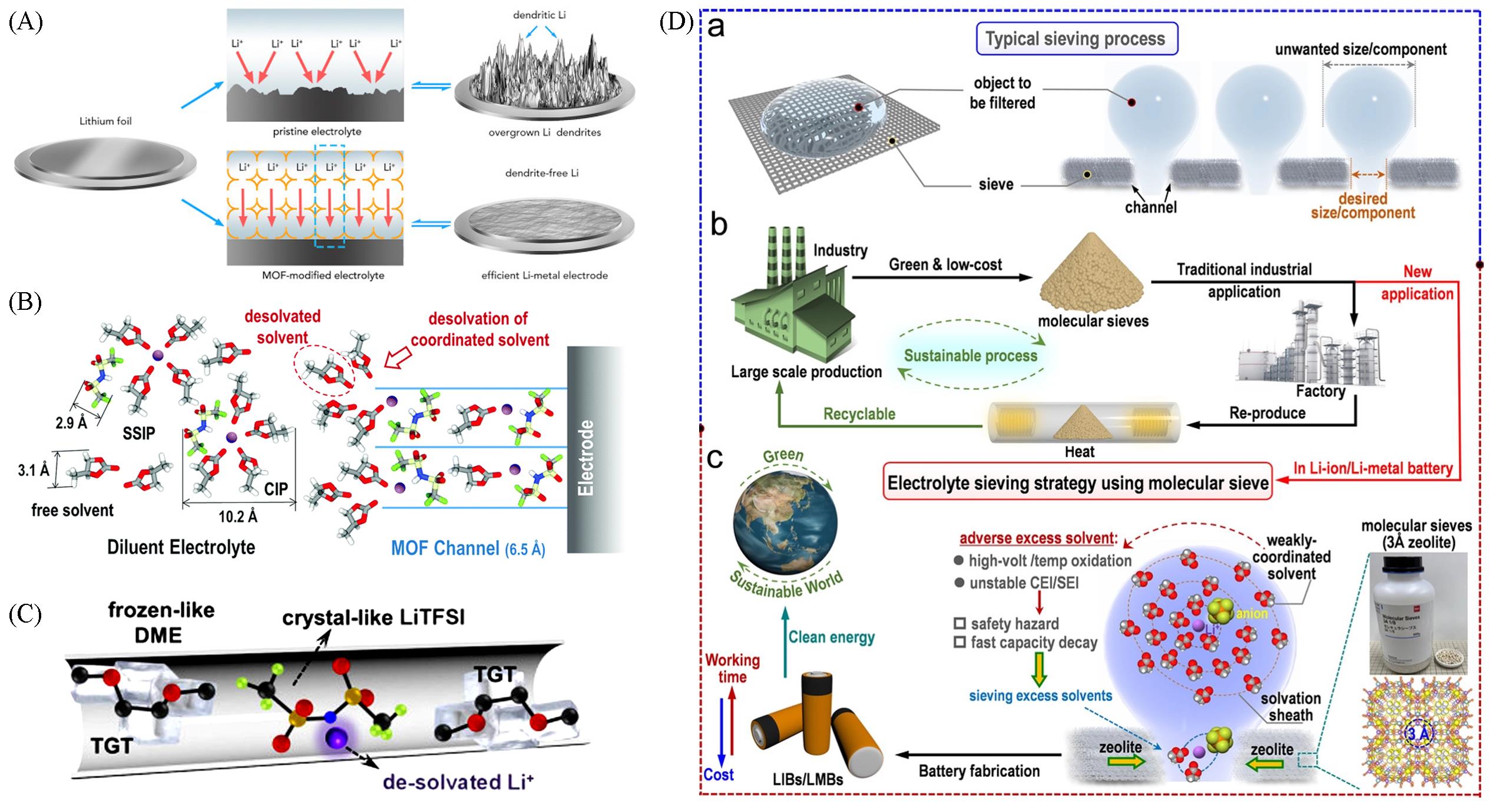
Fig.5 Schematic illustration of the Li⁃metal electrode with pristine electrolyte or MOF⁃modified electrolyte(A) [ 100], the configuration for the unique electrolyte achieved inside MOF channels(B) [ 101], inactive “frozen⁃like” solvents, de⁃solvated lithium ions and crystal⁃like lithium salt solute within MOF channel(C) [ 102] and new application of recyclable and low⁃cost molecular sieves in lithium⁃ion battery/lithium⁃metal battery system(D) [ 105](A) Copyright 2018, Elsevier; (B) Copyright 2020, the Royal Society of Chemistry; (C) Copyright 2020, Elsevier; (D) Copyright 2021, John Wiley and Sons.
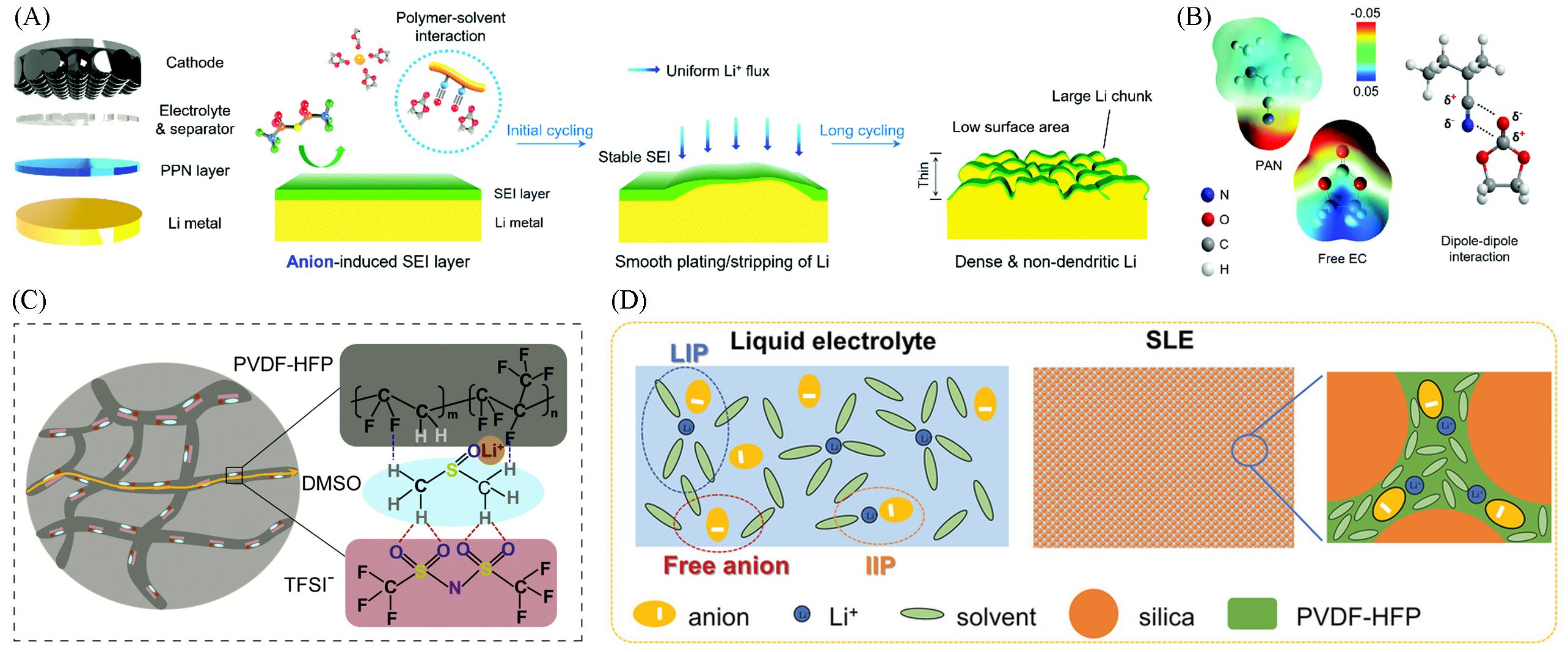
Fig.6 Schematic illustration of anion⁃induced SEI layer formation on PAN Li stabilizing Li surface during the cycling(A), electrostatic potential maps of PAN and EC and schematic illustration of dipole⁃dipole interaction between C≡N and C=O groups of PAN and EC(B) [ 112], schematic illustration of Li + transport model in the S⁃LHCE(C) [ 113] and schematic illustration of solvation model in liquid electrolyte and solid⁃like electrolyte with Si2O(D) [ 114](A, B) Copyright 2019, the Royal Society of Chemistry; (C) Copyright 2022, the Royal Society of Chemistry; (D) Copyright 2022, John Wiley and Sons.
| 1 | Hall P. J., Bain E. J., Energy Policy, 2008, 36, 4352—4355 |
| 2 | Cheng X. B., Zhang R., Zhao C. Z., Wei F., Zhang J. G., Zhang Q., Adv. Sci., 2016, 3, 1500213 |
| 3 | Xu K., Chem. Rev., 2014, 114, 11503—11618 |
| 4 | Li M., Lu J., Chen Z. W., Amine K., Adv. Mater., 2018, 30, 1800561 |
| 5 | Liang Y. R., Zhao C. Z., Yuan H., Chen Y., Zhang W. C., Huang J. Q., Yu D. S., Liu Y. L., Titirici M., Chueh Y. L., Yu H. J., Zhang Q., InfoMat, 2019, 1, 6—32 |
| 6 | Kong L., Tang C., Peng H. J., Huang J. Q., Zhang Q., SmartMat, 2020, 1, e1007 |
| 7 | Goodenough J. B., Kim Y., Chem. Mater., 2009, 22, 587—603 |
| 8 | Albertus P., Babinec S., Litzelman S., Newman A., Nat. Energy, 2017, 3, 16—21 |
| 9 | Xu W., Wang J. L., Ding F., Chen X. L., Nasybulin E., Zhang Y. H., Zhang J. G., Energy Environ. Sci., 2014, 7, 513—537 |
| 10 | Cheng X. B., Zhang R., Zhao C. Z., Zhang Q., Chem. Rev., 2017, 117, 10403—10473 |
| 11 | Lin D. C., Liu Y. Y., Cui Y., Nat. Nanotechnol., 2017, 12, 194—206 |
| 12 | Shen X., Zhang X. Q., Ding F., Huang J. Q., Xu R., Chen X., Yan C., Su F. Y., Chen C. M., Liu X. J., Zhang Q., Energy Mater. Adv., 2021, 2021, 1205324 |
| 13 | Cai W. L., Yao Y. X., Zhu G. L., Yan C., Jiang L. L., He C. X., Huang J. Q., Zhang Q., Chem. Soc. Rev., 2020, 49, 3806—3833 |
| 14 | Ding J. F., Xu R., Yan C., Li B. Q., Yuan H., Huang J. Q., J. Energy Chem., 2021, 59, 306—319 |
| 15 | Zhao C. Z., Chen P. Y., Zhang R., Chen X., Li B. Q., Zhang X. Q., Cheng X. B., Zhang Q., Sci. Adv., 2018, 4, eaat3446 |
| 16 | Shen X., Zhang R., Chen X., Cheng X. B., Li X. Y., Zhang Q., Adv. Energy Mater., 2020, 10, 1903645 |
| 17 | Paled E., J. Electrochem. Soc., 1979, 126, 2047 |
| 18 | Yan C., Yuan H., Park H. S., Huang J. Q., J. Energy Chem., 2019, 47, 217—220 |
| 19 | Zhang X. Q., Cheng X. B., Zhang Q., Adv. Mater. Interfaces, 2018, 5, 1701097 |
| 20 | Wu H. P., Jia H., Wang C. M., Zhang J. G., Xu W., Adv. Energy Mater., 2020, 11, 2003092 |
| 21 | Ramasubramanian A., Yurkiv V., Foroozan T., Ragone M., Shahbazian Yassar R., Mashayek F., J. Phys. Chem. C, 2019, 123, 10237—10245 |
| 22 | Chen X. R., Yao Y. X., Yan C., Zhang R., Cheng X. B., Zhang Q., Angew. Chem. Int. Ed., 2020, 59, 7743—7747 |
| 23 | Cui C. Y., Yang C. Y., Eidson N., Chen J., Han F., Chen L., Luo C., Wang P. F., Fan X., Wang C. S., Adv. Mater., 2020, 32, 1906427 |
| 24 | Suo L. M., Hu Y. S., Li H., Armand M., Chen L. Q., Nat. Commun., 2013, 4, 1481 |
| 25 | Wei S. Y., Choudhury S., Tu Z. Y., Zhang K. H., Archer L. A., Acc. Chem. Res., 2018, 51, 80—88 |
| 26 | Peled E., Menkin S., J. Electrochem. Soc., 2017, 164, A1703—A1719 |
| 27 | Li Y. Z., Huang W., Li Y. B., Pei A., Boyle D. T., Cui Y., Joule, 2018, 2, 2167—2177 |
| 28 | Xu R., Huang J. Q., Zhang Q., Matter, 2019, 1, 300—301 |
| 29 | Shi S., Lu P., Liu Z. Y., Qi Y., Hector L. G. Jr., Li H., Harris S. J., J. Am. Chem. Soc., 2012, 134, 15476—15487 |
| 30 | Peled E., Golodnitsky D., Ardel G., J. Electrochem. Soc., 1997, 144, L208 |
| 31 | Fan X. L., Ji X., Han F. D., Yue J., Chen J., Chen L., Deng T., Jiang J. J., Wang C. S., Sci. Adv., 2018, 4, eaau9245 |
| 32 | Xu R., Yan C., Xiao Y., Zhao M., Yuan H., Huang J. Q., Energy Stor. Mater., 2020, 28, 401—406 |
| 33 | Ding J. F., Xu R., Ma X. X., Xiao Y., Yao Y. X., Yan C., Huang J. Q., Angew. Chem. Int. Ed., 2021, 61, e202115602 |
| 34 | Wang W. W., Gu Y., Yan H., Li K. X., Chen Z. B., Wu Q. H., Kranz C., Yan J. W., Mao B. W., Faraday Discuss., 2022, 233, 190—205 |
| 35 | Xu R., Yan C., Huang J. Q., Trends Chem., 2020, 3, 5—14 |
| 36 | Kamesui G., Nishikawa K., Ueda M., Matsushima H., ACS Energy Lett., 2022, 7, 4089—4097 |
| 37 | Xu R., Xiao Y., Zhang R., Cheng X. B., Zhao C. Z., Zhang X. Q., Yan C., Zhang Q., Huang J. Q., Adv. Mater., 2019, 31, 1808392 |
| 38 | Xu R., Cheng X. B., Yan C., Zhang X. Q., Xiao Y., Zhao C. Z., Huang J. Q., Zhang Q., Matter, 2019, 1, 317—344 |
| 39 | Xu R., Zhang X. Q., Cheng X. B., Peng H. J., Zhao C. Z., Yan C., Huang J. Q., Adv. Funct. Mater., 2018, 28, 1705838 |
| 40 | Liu W., Liu P. C., Mitlin D., Adv. Energy Mater., 2020, 10, 2002297 |
| 41 | Li M., Wang C. S., Chen Z. W., Xu K., Lu J., Chem. Rev., 2020, 120, 6783—6819 |
| 42 | Jin C. B., Yao N., Xiao Y., Xie J., Li Z., Chen X., Li B. Q., Zhang X. Q., Huang J. Q., Zhang Q., Adv. Mater., 2022, e2208340 |
| 43 | Cui C., Yang H., Zeng C., Gui S. W., Liang J. N., Xiao P., Wang S. H., Huang G. X., Hu M. T., Zhai T. Y., Li H. Q., Sci. Adv., 2022, 8, eadd2000 |
| 44 | Cheng H. R., Sun Q. J., Li L. L., Zou Y. G., Wang Y. Q., Cai T., Zhao F., Liu G., Ma Z., Wahyudi W., Li Q., Ming J., ACS Energy Lett., 2022, 7, 490—513 |
| 45 | Piao Z. H., Gao R. H., Liu Y. Q., Zhou G. M., Cheng H. M., Adv. Mater., 2022, doi:10.1002/adma.202206009 |
| 46 | Wang Z. S., Wang H. P., Qi S. H., Wu D. X., Huang J. D., Li X., Wang C. Y., Ma J. M., EcoMat, 2022, 4, e12200 |
| 47 | Yan C., Xu R., Xiao Y., Ding J. F., Xu L., Li B. Q., Huang J. Q., Adv. Funct. Mater., 2020, 30, 1909887 |
| 48 | Seo D. M., Borodin O., Han S. D., Ly Q., Boyle P. D., Henderson W. A., J. Electrochem. Soc., 2012, 159, A553—A565 |
| 49 | Chen X., Li H. R., Shen X., Zhang Q., Angew. Chem. Int. Ed., 2018, 57, 16643—16647 |
| 50 | Chen X., Zhang X. Q., Li H. R., Zhang Q., Batteries Supercaps, 2019, 2, 128—131 |
| 51 | Chen X., Zhang Q., Acc. Chem. Res., 2020, 53, 1992—2002 |
| 52 | Chen X., Shen X., Li B., Peng H. J., Cheng X. B., Li B. Q., Zhang X. Q., Huang J. Q., Zhang Q., Angew. Chem. Int. Ed., 2018, 57, 734—737 |
| 53 | Chen Y. C., Ouyang C. Y., Song L. J., Sun Z. L., J. Phys. Chem. C, 2011, 115, 7044—7049 |
| 54 | Weiling M., Pfeiffer F., Baghernejad M., Adv. Energy Mater., 2022, 2202504 |
| 55 | Kim S., Seo B., Ramasamy H. V., Shang Z. X., Wang H., Savoie B. M., Pol V. G., ACS Appl. Mater. Interfaces, 2022, 14, 41934—41944 |
| 56 | Yamada Y., Wang J. H., Ko S., Watanabe E., Yamada A., Nat. Energy, 2019, 4, 269—280 |
| 57 | Yao Y. X., Chen X., Yan C., Zhang X. Q., Cai W. L., Huang J. Q., Zhang Q., Angew. Chem. Int. Ed., 2021, 60, 4090—4097 |
| 58 | Groß A., Sakong S., Curr. Opin. Electrochem., 2019, 14, 1—6 |
| 59 | Yan C., Li H. R., Chen X., Zhang X. Q., Cheng X. B., Xu R., Huang J. Q., Zhang Q., J. Am. Chem. Soc., 2019, 141, 9422—9429 |
| 60 | Xu R., Shen X., Ma X. X., Yan C., Zhang X. Q., Chen X., Ding J. F., Huang J. Q., Angew. Chem. Int. Ed., 2021, 60, 4215—4220 |
| 61 | Zhang Q. L., Pan J., Lu P., Liu Z. Y., Verbrugge M. W., Sheldon B. W., Cheng Y. T., Qi Y., Xiao X. C., Nano Lett., 2016, 16, 2011—2016 |
| 62 | Von Wald Cresce A., Borodin O., Xu K., J. Phys. Chem. C, 2012, 116, 26111—26117 |
| 63 | Zhang X. Q., Cheng X. B., Chen X., Yan C., Zhang Q., Adv. Funct. Mater., 2017, 27, 1605989 |
| 64 | Hou T. Z., Yang G., Rajput N. N., Self J., Park S. W., Nanda J., Persson K. A., Nano Energy, 2019, 64, 103881 |
| 65 | Zhang X. Q., Chen X., Hou L. P., Li B. Q., Cheng X. B., Huang J. Q., Zhang Q., ACS Energy Lett., 2019, 4, 411—416 |
| 66 | Yan C., Yao Y. X., Chen X., Cheng X. B., Zhang X. Q., Huang J. Q., Zhang Q., Angew. Chem. Int. Ed., 2018, 57, 14055—14059 |
| 67 | Zhang X. Q., Chen X., Cheng X. B., Li B. Q., Shen X., Yan C., Huang J. Q., Zhang Q., Angew. Chem. Int. Ed., 2018, 57, 5301—5305 |
| 68 | Qian J., Henderson W. A., Xu W., Bhattacharya P., Engelhard M., Borodin O., Zhang J. G., Nat. Commun., 2015, 6, 6362 |
| 69 | Sheng L., Wu Y. Z., Tian J. K., Wang L., Wang J. L., Tang Y. P., Xu H., He X. M., Energy Environ. Mater., 2022, 6, e12266 |
| 70 | Su L., Jo E., Manthiram A., ACS Energy Lett., 2022, 7, 2165—2172 |
| 71 | Wang J. H., Yamada Y., Sodeyama K., Chiang C. H., Tateyama Y., Yamada A., Nat. Commun., 2016, 7, 12032 |
| 72 | Xu K., Chem. Rev., 2004, 104, 4303—4417 |
| 73 | Jiao S. H., Ren X. D., Cao R. G., Engelhard M. H., Liu Y., Hu D. H., Mei D. H., Zheng J. M., Zhao W. G., Li Q. Y., Liu N., Adams B. D., Ma C., Liu J., Zhang J. G., Xu W., Nat. Energy, 2018, 3, 739—746 |
| 74 | Wang L., Luo Z., Xu H., Piao N., Chen Z. H., Tian G. Y., He X. M., RSC Adv., 2019, 9, 41837—41846 |
| 75 | Chen S. R., Zheng J. M., Mei D. H., Han K. S., Engelhard M. H., Zhao W. G., Xu W., Liu J., Zhang J. G., Adv. Mater., 2018, 30, 1706102 |
| 76 | Perez Beltran S., Cao X., Zhang J. G., Balbuena P. B., Chem. Mater., 2020, 32, 5973—5984 |
| 77 | Ren X. D., Gao P. Y., Zou L. F., Jiao S. H., Cao X., Zhang X. H., Jia H., Engelhard M. H., Matthews B. E., Wu H., Lee H., Niu C. N., Wang C. M., Arey B. W., Xiao J., Liu J., Zhang J. G., Xu W., Proc. Natl. Acad. Sci. USA, 2020, 117, 28603—28613 |
| 78 | Cao X., Gao P. Y., Ren X. D., Zou L. F., Engelhard M. H., Matthews B. E., Hu J. T., Niu C. J., Liu D. Y., Arey B. W., Wang C., Xiao J., Liu J., Xu W., Zhang J. G., Proc. Natl. Acad. Sci. USA, 2021, 118, e2020357118 |
| 79 | Ding J. F., Xu R., Yao N., Chen X., Xiao Y., Yao Y. X., Yan C., Xie J., Huang J. Q., Angew. Chem. Int. Ed., 2021, 60, 11442—11447 |
| 80 | Yan C., Jiang L. L., Yao Y. X., Lu Y., Huang J. Q., Zhang Q., Angew. Chem. Int. Ed., 2021, 60, 8521—8525 |
| 81 | Liu Y., Sun Q. T., Yu P. P., Wu Y., Xu L., Yang H., Xie M., Cheng T., Goddard W. A., J. Phys. Chem. Lett., 2021, 12, 2922—2929 |
| 82 | Holoubek J., Kim K., Yin Y. J., Wu Z. H., Liu H. D., Li M. Q., Chen A., Gao H. P., Cai G. R., Pascal T. A., Liu P., Chen Z., Energy Environ. Sci., 2022, 15, 1647—1658 |
| 83 | Xiao P. T., Luo R. P., Piao Z. H., Li C., Wang J. X., Yu K., Zhou G. M., Cheng H. M., ACS Energy Lett., 2021, 6, 3170—3179 |
| 84 | Xiao Y., Xu R., Xu L., Ding J. F., Huang J. Q., Energy Mater., 2022, 1, 100013 |
| 85 | Yu Z. A., Wang H. S., Kong X., Huang W., Tsao Y., Mackanic D. G., Wang K., Wang X. C., Huang W. X., Choudhury S., Zheng Y., Amanchukwu C. V., Hung S. T., Ma Y. T., Lomeli E. G., Qin J., Cui Y., Bao Z. N., Nat. Energy, 2020, 5, 526—533 |
| 86 | Wang H., Yu Z. S., Kong X., Huang W., Zhang Z. W., Mackanic D. G., Huang X. Y., Qin J., Bao Z. N., Cui Y., Adv. Mater., 2021, 33, 2008619 |
| 87 | Zhou T. H., Zhao Y., El Kazzi M., Choi J. W., Coskun A., Angew. Chem. Int. Ed., 2022, 61, e202115884 |
| 88 | Zhao Y., Zhou T. H., Ashirov T., Kazzi M. E., Cancellieri C., Jeurgens L. P. H., Choi J. W., Coskun A., Nat. Commun., 2022, 13, 2575 |
| 89 | Chen Y. L., Yu Z. A., Rudnicki P., Gong H. X., Huang Z. J., Kim S. C., Lai J. C., Kong X., Qin J., Cui Y., Bao Z. N., J. Am. Chem. Soc., 2021, 143, 18703—18713 |
| 90 | Holoubek J., Liu H. D., Wu Z. H., Yin Y. J., Xing X., Cai G. R., Yu S., Zhou H. Y., Pascal T. A., Chen Z., Liu P., Nat. Energy, 2021, 6, 303—313 |
| 91 | Huang Y. Q., Li R. H., Weng S. T., Zhang H. K., Zhu C. N., Lu D., Sun C. C., Huang X. T., Deng T., Fan L. W., Chen L. X., Wang X. F., Fan X. L., Energy Environ. Sci., 2022, 15, 4349—4361 |
| 92 | Li S., Jiang M. W., Xie Y., Xu H., Jia J. Y., Li J., Adv. Mater., 2018, 30, 1706375 |
| 93 | Yang S. J., Yao N., Jiang F. N., Xie J., Sun S. Y., Chen X., Yuan H., Cheng X. B., Huang J. Q., Zhang Q., Angew. Chem. Int. Ed., 2022, e202214545 |
| 94 | Zhang Q. K., Zhang X. Q., Yuan H., Huang J. Q., Small Sci., 2021, 1, 2100058 |
| 95 | Fan X. L., Chen L., Borodin O., Ji X., Chen J., Hou S., Deng T., Zheng J., Yang C. Y., Liou S. C., Amine K., Xu K., Wang C. S., Nat. Nanotechnol., 2018, 13, 715—722 |
| 96 | Liu K., Pei A., Lee H. R., Kong B., Liu N., Lin D. C., Liu Y. Y., Liu C., Hsu P. C., Bao Z. N., Cui Y., J. Am. Chem. Soc., 2017, 139, 4815—4820 |
| 97 | Xin S., You Y., Wang S. F., Gao H. C., Yin Y. X., Guo Y. G., ACS Energy Lett., 2017, 2, 1385—1394 |
| 98 | Yang H. X., Liu Z. K., Wang Y., Li N. W., Yu L., Adv. Funct. Mater., 2022, 2209837 |
| 99 | Han X., Wu T. T., Gu L. H., Chen M. F., Song J. Z., Tian D., Chen J. Z., Chin. Chem. Lett., 2023, 34, 107594 |
| 100 | Bai S. Y., Sun Y., Yi J., He Y., Qiao Y., Zhou H. S., Joule, 2018, 2, 2117—2132 |
| 101 | Chang Z., Qiao Y., Yang H. J., Deng H., Zhu X. Y., He P., Zhou H. S., Energy Environ. Sci., 2020, 13, 4122—4131 |
| 102 | Chang Z., Qiao Y., Deng H., Yang H. J., He P., Zhou H. S., Joule, 2020, 4, 1776—1789 |
| 103 | Huang K., Zhai P., Chen J., Xiao J., Gong Y., Zhang X., Peng X., Xiang Y., Electrochem. Commun., 2022, 144/145, 107395 |
| 104 | Kim M. S., Zhang Z., Rudnicki P. E., Yu Z., Wang J., Wang H., Oyakhire S. T., Chen Y., Kim S. C., Zhang W., Boyle D. T., Kong X., Xu R., Huang Z., Huang W., Bent S. F., Wang L. W., Qin J., Bao Z., Cui Y., Nat. Mater., 2022, 21, 445—454 |
| 105 | Chang Z., Qiao Y., Yang H. J., Cao X., Zhu X. Y., He P., Zhou H. S., Angew. Chem. Int. Ed., 2021, 60, 15572—15581 |
| 106 | Ma S. X., Shen L., Liu Q., Shi W. Y., Zhang C., Liu F., Baucom J. A., Zhang D., Yue H. J., Wu H. B., Lu Y. F., ACS Appl. Mater. Interfaces, 2020, 12, 43824—43832 |
| 107 | Cui S. L., Wu X. W., Yang Y., Fei M. F., Liu S., Li G. R., Gao X. P., ACS Energy Lett., 2021, 7, 42—52 |
| 108 | Cheng X. L., Pan J., Zhao Y., Liao M., Peng H. S., Adv. Energy Mater., 2018, 8, 1702184 |
| 109 | Chen D. L., Zhu M., Kang P. B., Zhu T., Yuan H. C., Lan J. L., Yang X. P., Sui G., Adv. Sci., 2022, 9, 2103663 |
| 110 | Liu M., Wang Y., Li M., Li G. Q., Li B., Zhang S. T., Ming H., Qiu J. Y., Chen J. H., Zhao P. C., Electrochim. Acta, 2020, 354, 136622 |
| 111 | He X., Ni Y. X., Hou Y. P., Lu Y., Jin S., Li H. X., Yan Z. H., Zhang K., Chen J., Angew. Chem. Int. Ed., 2021, 60, 22672—22677 |
| 112 | Bae J., Qian Y. M., Li Y. T., Zhou X. Y., Goodenough J. B., Yu G. H., Energy Environ. Sci., 2019, 12, 3319—3327 |
| 113 | Xu S. J., Xu R. G., Yu T., Chen K., Sun C. G., Hu G. J., Bai S., Cheng H. M., Sun Z. H., Li F., Energy Environ. Sci., 2022, 15, 3379—3387 |
| 114 | Zhang T., Li J. F., Li X. X., Wang R. T., Wang C. X., Zhang Z. W., Yin L. W., Adv. Mater., 2022, 2205575 |
| 115 | Xiao J., Zhai P. B., Wei Y., Zhang X. Y., Yang W. W., Cui S. Q., Jin C. Q., Liu W., Wang X. G., Jiang H., Luo Z. L., Zhang X. K., Gong Y. J., Nano Lett., 2020, 20, 3911—3917 |
| 116 | Gao Z. G., Zhang S. J., Huang Z. G., Lu Y. Q., Wang W. W., Wang K., Li J. T., Zhou Y., Huang L., Sun S. G., Chin. Chem. Lett., 2019, 30, 525—528 |
| 117 | Pang Y. C., Guan M., Pan Y., Tian M., Huang K., Jiang C. Z., Xiang A., Wang X. Q., Gong Y. J., Xiang Y., Zhang X. K., Small, 2022, 18, e2104832 |
| [1] | 屠兴超, 古兴兴, 赖超. 基于三维亲锂材料的高稳定金属锂负极的构筑[J]. 高等学校化学学报, 2023, 44(5): 133. |
| [2] | 徐攀, 孔伟进, 黄雪妍, 孙硕, 黄文泽, 赵辰孜. 固态锂金属电池中原位聚合电解质的研究进展[J]. 高等学校化学学报, 2023, 44(5): 20220670. |
| [3] | 李威, 罗飘, 黄廉湛, 崔志明. 基于聚苯乙烯磺酸的锂金属负极界面保护层的设计[J]. 高等学校化学学报, 2022, 43(8): 20220166. |
| [4] | 詹迎新, 石鹏, 张学强, 魏俊宇, 张乾魁, 黄佳琦. 锂金属负极亲锂骨架的研究进展[J]. 高等学校化学学报, 2021, 42(5): 1569. |
| [5] | 李曈, 谷思辰, 林乔伟, 韩俊伟, 周光敏, 李宝华, 康飞宇, 吕伟. 基于三维集流体的无枝晶锂金属负极[J]. 高等学校化学学报, 2021, 42(5): 1480. |
| [6] | 王增强, 孙一翎, 钱正芳, 王任衡. 基于表界面反应及优化的锂金属电池研究进展[J]. 高等学校化学学报, 2021, 42(4): 1017. |
| [7] | 邹俊彦, 张焱焱, 陈石, 邵怀宇, 汤育欣. 全固态锂金属电池表界面化学的研究进展[J]. 高等学校化学学报, 2021, 42(4): 1005. |
| [8] | 高小雅, 左自成, 李玉良. 石墨炔电化学电池界面构筑[J]. 高等学校化学学报, 2021, 42(2): 321. |
| [9] | 王凤春, 周万里. 离子型添加剂四丁基胺-双(氟磺酰)亚胺对锂电池性能的影响[J]. 高等学校化学学报, 2018, 39(11): 2529. |
| 阅读次数 | ||||||
|
全文 |
|
|||||
|
摘要 |
|
|||||